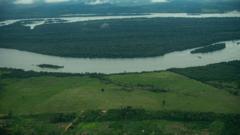A recent report reveals the most extensive coral bleaching in nearly 40 years, posing alarming threats to marine biodiversity.
**Catastrophic Coral Loss on the Great Barrier Reef: A Grim New Record**

**Catastrophic Coral Loss on the Great Barrier Reef: A Grim New Record**
The Great Barrier Reef faces unprecedented coral decline, with climate change pushing it to a tipping point.
Australia's Great Barrier Reef has recorded its largest annual coral cover decline in history, according to the latest findings from the Australian Institute of Marine Science (AIMS). The report indicates that both the northern and southern sections of the reef have undergone widespread coral bleaching, marking the most severe degradation since monitoring commenced nearly 40 years ago.
Recent tropical cyclones and infestations of crown-of-thorns starfish, which consume coral, have further contributed to the reef's woes. However, climate change, through heightened water temperatures, remains the primary catalyst for the alarming coral decline, AIMS warns. The researchers are concerned that the reef may reach an irretrievable tipping point, where it cannot rejuvenate fast enough in the face of ongoing catastrophic events, predicting a "volatile" future for this critical habitat.
AIMS conducted health surveys on 124 coral reefs between August 2024 and May 2025, with historical data dating back to 1986. Known as the largest living structure on Earth, the Great Barrier Reef stretches approximately 2,300 kilometers (1,429 miles) and supports an extraordinary range of marine biodiversity. Nonetheless, repeated bleaching events are turning large areas of the once-healthy coral stark white.
Coral is often referred to as the ocean's architect, as it is integral in forming structures that provide habitats for around 25% of all marine species. Bleaching occurs when coral experiences stress due to excessively high water temperatures, resulting in a loss of color as it expels the symbiotic algae it relies on for nutrients.
Coral can occasionally recover from such stress, but it typically requires an extended period—ideally years—to heal. If water temperatures exceed the coral's thermal limits by 1C (1.8F) for more than two months, the likelihood of death increases dramatically. The Great Barrier Reef faced considerable heat stress since early 2024, marking the sixth significant bleaching event since 2016. Natural phenomena like El Niño have also contributed to the frequency and intensity of these events.
The AIMS report underscores that the unprecedented levels of heat stress have led to the most extensive and severe cases of bleaching ever documented. Unfortunately, recovery is contingent upon future coral reproduction and reduced environmental disturbances. Among the most affected species during the evaluations were Acropora corals, which are not only particularly vulnerable to heat stress but also are favored by the crown-of-thorns starfish.
Dr. Mike Emslie, AIMS research lead, noted the significance of the Great Barrier Reef's natural beauty and the inherent potential for recovery, emphasizing the importance of conservation efforts. There have been positive developments through the Australian government’s intervention programs targeting crown-of-thorns starfish, which has seen over 50,000 of these coral-consuming creatures eliminated using environmentally safe methods.
Richard Leck from WWF warns that the findings of the report highlight an ecosystem under immense strain, expressing concern over the possibility of the reef failing to recover in the long term. He cautioned that some coral reefs globally are already facing collapse, and without substantial and rapid climate action, the Great Barrier Reef could meet a similar fate.
While the Great Barrier Reef has enjoyed protection as a UNESCO World Heritage site for over four decades, experts maintain that it is in jeopardy from rising ocean temperatures and pollution.




















